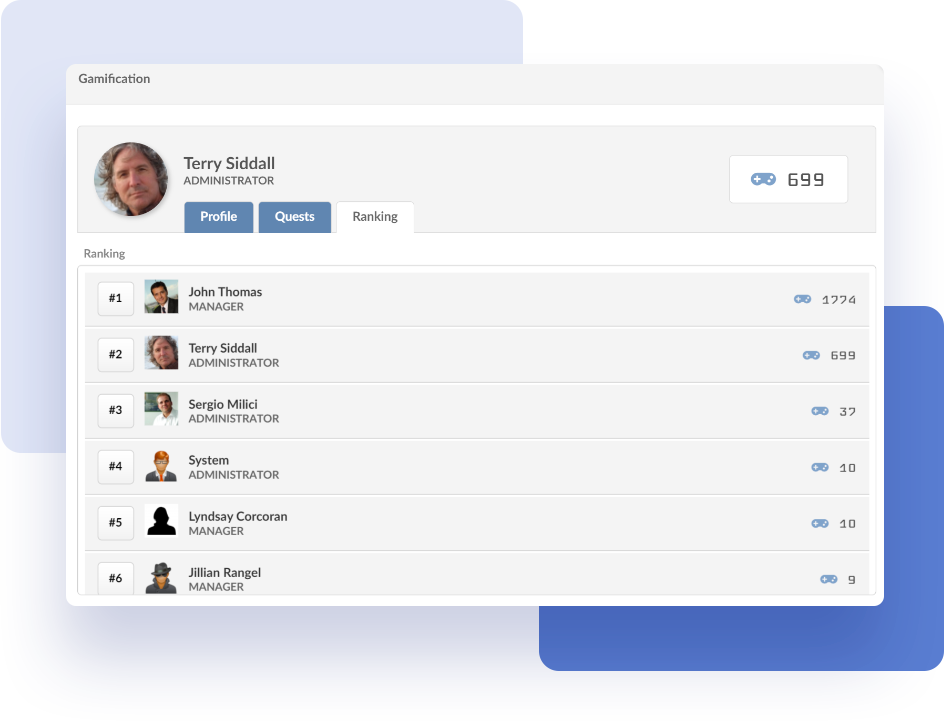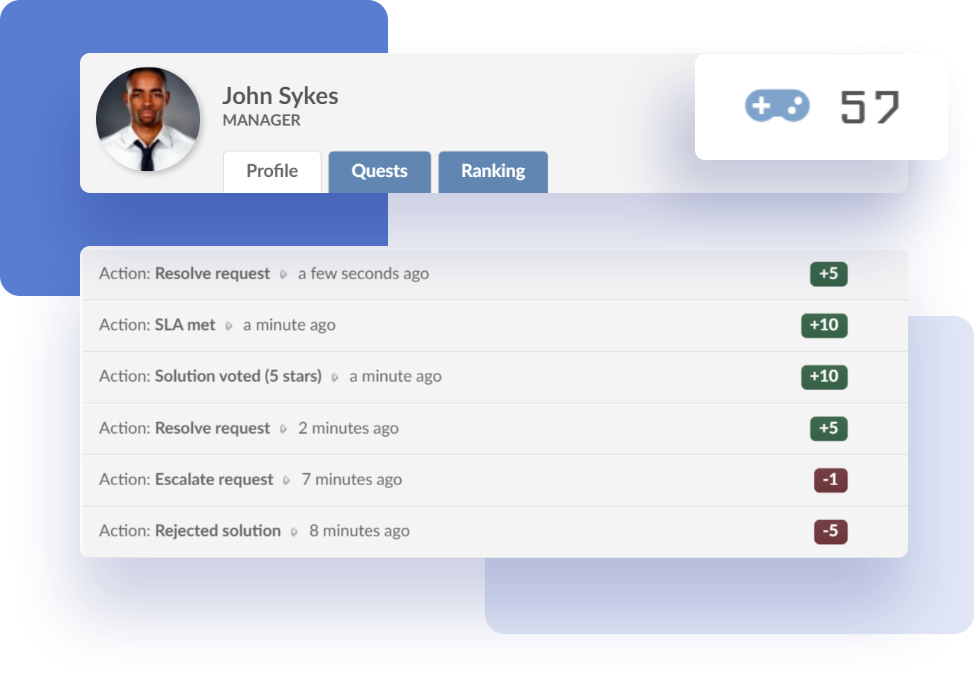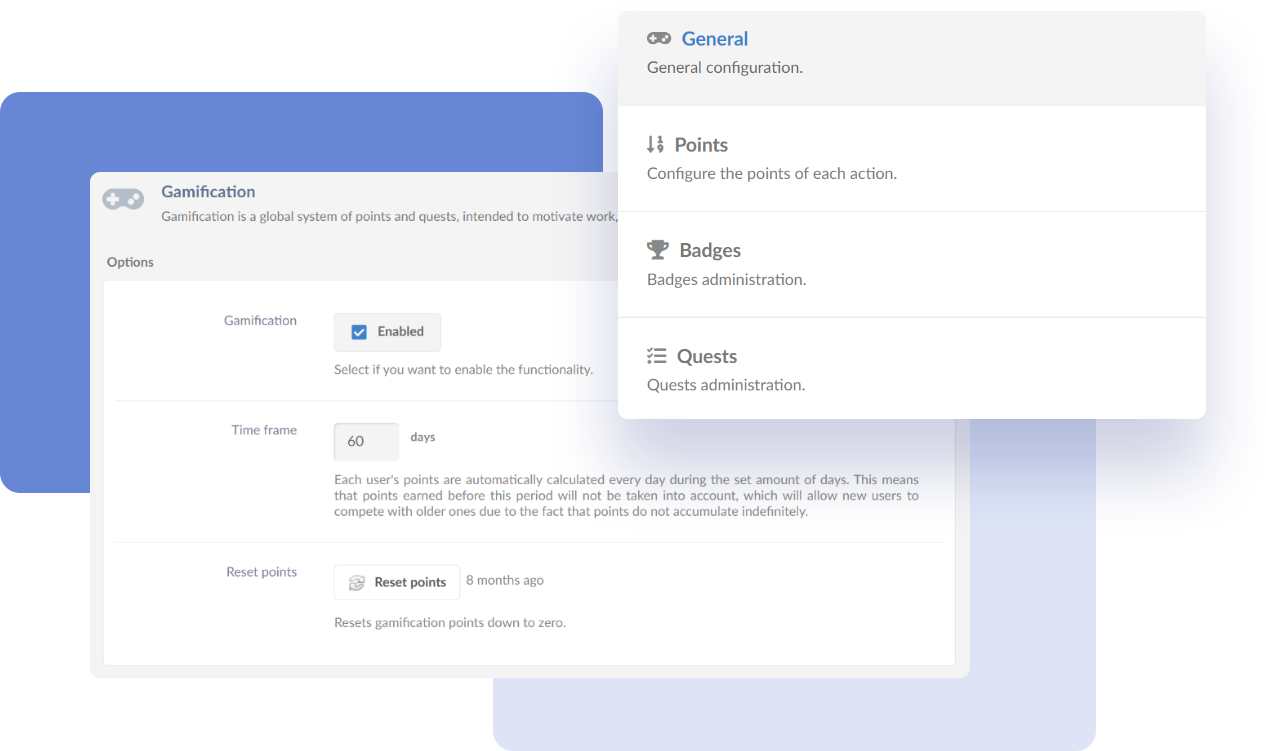We hear a lot about gamification in IT, but it can sometimes be unclear how to implement it, its benefits and challenges, and which tools are indispensable to succeed. Keeping agents motivated can be a struggle in itself, we know. Staff demotivation is not uncommon due to multiple factors – such as end-user complaints, burnout because of constant incoming incidents, and the monotony of some service desk tasks – and can lead to high agent turnover.

The good news is that you can do something about it. About one-half of American workers are casual gamers outside of work. Thus, implementing a gamification strategy can be a great way to use this in your favor and encourage your team! Plus, you won't believe how easy it is to do it with the Gamification module of InvGate Service Management.
After going through this article, you'll be able to give your team the impulse to boost their spirit and productivity thanks to some tips and tricks to implement service desk gamification and avoid the most common pitfalls.
Ready, set, go!

What is gamification in business?
In business, gamification is taking elements from game designs and applying them to make a task or job more interesting by adding some fun activities or elements. It can be applied in many different places, like the IT service desk or any job involving many tasks and paperwork.

It has become increasingly popular in IT service desks as organizations strive to find new ways of keeping agents motivated and engaged. Some studies show that employees' engagement increased by 48% with gamification. So, it's become a popular way to encourage agents to stay motivated and excited about their job, take on challenges, learn new skills, thrive through complex tasks, and discover new working methods.
How gamification works
When a manager implements a gamification strategy, it aims to make people behave correctly. This could be learning new skills, reaching some metrics, or completing a particular task.
In IT, gamification rewards the agents for completing tasks or reaching certain goals. Rewards can take many forms, from virtual points and badges to tangible prizes like gift cards or days off. It's important to note that it doesn't only focus on rewarding agents who go above and beyond their duties; everyone should be given credit for their work.

The rewards can be tailored to the agents' preferences so they become more meaningful. This helps foster motivation and engagement, as well as a sense of pride when the agent achieves what was expected of them. Always keep in mind that while rewards are also part of the strategy, it's not all about getting points or awards. The main goal is to make the process more fun and engaging.
When implementing this strategy, your main goal should be to create an environment where agents can feel excited to work and contribute with their best efforts. People can be motivated by different things, so when setting up the gamification process, you must make an effort to tailor certain aspects to focus on what motivates your team and which objectives they want to achieve.
Read More: 5 Examples of How Gamification Can Improve Your Results
Pros and cons of gamification in the service desk
Gamification can be a great way to make the service desk more engaging and keep agents motivated. The main advantages of using gamification for the IT service desk are:
- Improving performance by providing incentives to reach goals.
- Enhancing team spirit & collaboration among agents.
- Increasing motivation & engagement within the team.
- Enhancing customer experience by providing more efficient and faster services.
- Creating a sense of accomplishment and recognition for agents.
However, we want you to have the whole picture before you plan on implementing it. There are also some disadvantages to consider:
- If not implemented correctly, it can lead to frustration or the feeling that it's just another way of monitoring performance.
- It can be time-consuming to set up.
- It needs to be continuously monitored and adjusted.
- It can create a competitive atmosphere, leading agents to feel devalued or unimportant.
- It can lead to agents "gaming" the system in order to get rewards.
- Only some people are inspired by it.
Gamification strategy: how to gamify your InvGate Service Management instance
InvGate Service Management offers you gamification functionalities to achieve the goals you have for your team and make the agents' jobs more enjoyable through game dynamics and entertainment.
In our tool, gamification works by points, achievements, batches, and a ranking system. Each time an agent carries out an action or series of actions, they will be rewarded with points to position them in a ranking.
So, before you set up the system, it's best to identify the behaviors you want to encourage. Once you've done that, it is time to configure InvGate Service Management to achieve those goals.
The first thing to do is activate the Gamification feature in your instance. Go to Settings >> Gamification >> General and enable the functionality. You can also set up the points' time frame and manually reset them to zero.

Once the feature is activated, the next step is to develop a point system that assigns a different amount of credits (whether positive or negative) to specific agent actions. This will be directly related to those behaviors you want to encourage (or discourage), and you can configure it from the Settings menu.
After doing this, move on to the badges your team members will receive when achieving goals. You can customize their names and images to match your company's brand and values.
To grant the points and badges, the last thing you need to create is a list of quests. This way, users that perform given sets of actions or accumulate a certain number of points will move forward the line and obtain the rewards. This is particularly helpful for setting a learning path and, for instance, onboarding new team members.
The last item on the list to implement a gamification strategy is to decide on the prizes. Even though badges are an excellent recognition, more than they might be needed to motivate your team. At this point, it'd be advisable to think about something else that is within your reach and can work as an extra incentive to achieve the different goals.
Rewards don't need to consume part of your budget, and you can come up with other ways to reward employees – such as public recognition of their efforts through email or in a meeting.
6 gamification best practices
When implementing a gamification strategy, there are some key points you should always keep in mind.
- The first gamification best practice is ensuring this is the right way to motivate your agents. Each team has its own dynamics and needs, so you should always take them into account.
- Second, you want to ensure the rewards are meaningful and motivating for your team. It would help if you considered a mix of different types of rewards, such as virtual points or badges, and tangible prizes, like gift cards and days off.
- Having a transparent point system and clear objectives is also essential to ensure everyone knows the gamification rules and what to expect from them. Plus, you will avoid misunderstandings and conflicts within your team.
- The gamification process should be continuously monitored and adjusted to be effective. Constantly monitor your agents' performance and engagement levels to understand if improvement is needed.
- Always be open to your team's feedback and adjust the strategy accordingly. They will always have valuable feedback to consider, and by hearing them out, they'll feel more involved in the process and motivated to reach goals.
- At last, remember the importance of recognition. Always thank and recognize your team members for their efforts so they feel valued.
By following these best practices, you can successfully implement a gamification strategy that works for your service desk.
8 ideas to apply gamification in IT
The gamification strategy is not something set in stone. There are many branches and possibilities, depending on your main goals, the team's dynamics and what gets them motivated, the organization's policies and compliance, and the available resources. So, each implementation should be custom and unique.
Nevertheless, you can use these eight ideas to get things going:
- Create a plan that helps you get ahead of potential issues or flaws that can ruin its development.
- Provide rewards for hitting certain KPIs such as response times, customer satisfaction ratings, or issue resolution rates.
- Offer virtual badges and titles to motivate service desk agents and make them feel appreciated.
- Develop a "level up" system that grants agents more privileges or bonus points when they reach certain milestones.
- Utilize gamification widgets to show agents their progress and motivate them to keep going.
- Create a knowledge-sharing platform where agents can earn points for submitting ideas, answers, and solutions.
- Develop an incentive program that motivates agents to reach a certain number of tickets closed or qualifications passed.
- Avoid unintended consequences. Thus, focus on what can actually work for your team.
Before you go...
Gamification can be an excellent incentive for your team to get better results. It requires planning, strategy, and the right resources to succeed. But before all of that, you need to understand its dynamics and clearly understand how to implement it in your service desk.
Though it can be a bit tricky at first, IT service desk gamification is excellent for improving your team's results, increasing motivation, and boosting engagement. So, if you want to give it a go, don't forget to:
- Plan your goals.
- Develop a point system.
- Set up badges.
- Create quests.
- Define rewards.
To do a correct implementation, communicate the rules to your team members so they know the points and rewards system. And monitor their progress to see if the plan is working.
Remember to check in with agents periodically to ask their opinion on the system and spot gaps and areas of improvement.
Start working on your gamification strategy today by getting a 30-day free trial of InvGate Service Management, and see the results for yourself!
Frequently Asked Questions
Does gamification work?
Yes, gamification is a powerful way to motivate and engage your team. However, it must be adequately implemented to have the desired results.
Why does gamification work?
Gamification works because it taps into our natural desire to compete and be rewarded for achievements. When used correctly, it can create a sense of accomplishment and recognition that drives people to do better and reach their desired goals.
How does gamification increase engagement?
Gamification increases engagement by creating an incentive system that rewards people when they complete certain tasks or reach specific goals. It also encourages social interaction and collaboration, leading to better results in the long run.
How is gamification changing business?
Because it allows companies to track and measure employee performance in real-time while providing incentives to motivate them to reach their goals. Additionally, it promotes a positive work environment and improves customer relationships.















